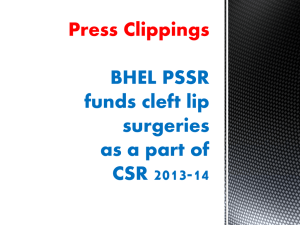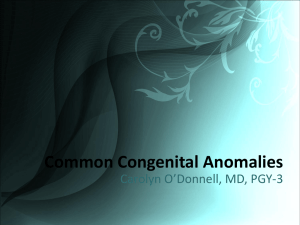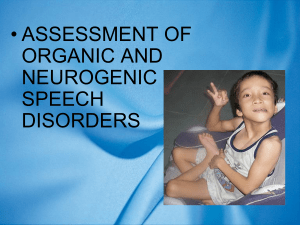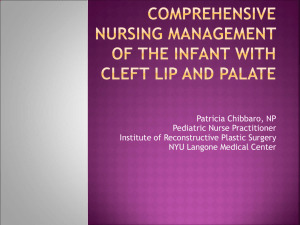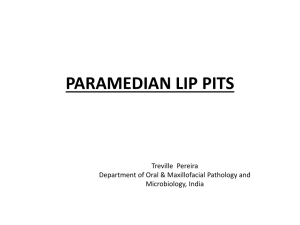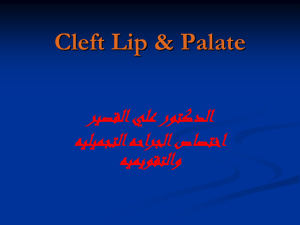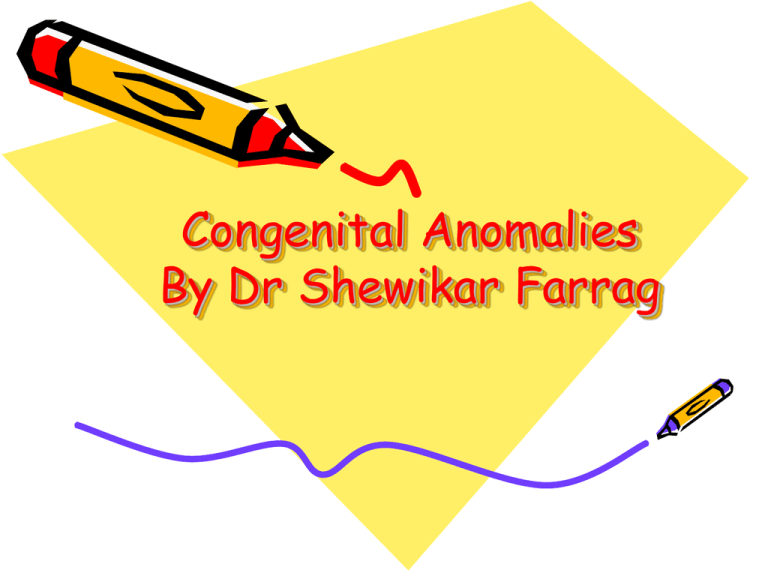
Congenital Anomalies
By Dr Shewikar Farrag
General objective
• To identify different congenital
anomalies that are present at birth.
Specific objectives:
• List the possible causes of fetal malformations.
• Define some common congenital anomalies in the newborn
infant.
• Describe some of the surgery related differences between
infants and adults.
• Outline important aspects in the pre and post operative
care of paediatric patients.
• Discuss specific pre and post operative care of a child with
the following: cleft lip, cleft palate, oesophageal atresia and
pyloric stenosis.
Causes of fetal malformation:
• Drugs
• Radiation
• Viruses
• Genetic traits
Common congenital anomalies in the newborn
•
Respiratory system:
•
Gastrointestinal system:
•
Anomalies of the stomach and duodenum:
•
Anomalies of the intestine:
- Laryngeal stridor
- Choanal atresia
- Anomalies of the mouth (cleft lip & cleft palate).
- Anomalies of the esophagus (esophageal atresia & chalasia of the esophagus).
- pyloric stenosis
- duodenal obstruction
- hiatus hernia
-
Imperforated anus.
Omphalocele.
Intestinal atresia.
Diaphragmatic hernia.
Hirschsprung’s disease (congenital aganglionic megacolon)
Intussusception
Congenital anomalies of the urinary system:
• Epispadias
• Hypospadias
• Phimosis
• Hydrocele
• Inguinal hernia
• Polycystic kidney
• Wilm’s Tumor (Embryoma)
Epispadias
• Mutual opening located on dorsal or
superior surface of the penis.
Hypospadias
• Urethral opening located behind
glands penis or anywhere along
ventral (lower) surface of penis
shaft.
N.B
• Infants with epispadias and hypospadias should
not be circumcised before repair of the defect
because the surgeon may wish to use a portion of
the foreskin for plastic repair.
Phimosis
• Narrowing or stenosis of preputial
opening of foreskin.
(in severe cases: circumcision or vertical division and
transverse, suturing of foreskin)
Hydrocele
• Fluid in scrotum.
Therapeutic management is surgical
repair indicated if spontaneous
resolution not accomplished in 1 year.
Inguinal hernia:
• Protrusion of abdominal contents
through inguinal canal into the
scrotum.
Therapeutic management includes:
detected as painless inguinal swelling
of variable size surgical closure of
inguinal defect.
Polycystic kidney:
The infant has enlarged kidneys filled
with cysts at birth
If the condition is bilateral, the infant will
not pass urine but if it is unilateral the
condition may be missed until later in life.
Wilm’s Tumor (Embryoma)
• It is a malignant tumor of the kidney that
arises from an embryonic structure
present in the child before birth;
The tumor is felt as an abdominal mass. It is
important that the necessary for diagnosis
because handling appears to increase the danger
of metastasis.
Skeletal defects affecting the nervous
system:
• Spina Bifida
• Spina Bifida Occulta
• Meningocele
• Meningomyelocele
• Hydrocephalus
Spina Bifida
• It is a defective closure of the
vertebral column.
It is more common in the lumbo sacral
region. It has varying degree of
tissue protrusion through the bony
cleft.
Spina Bifida Occulta
Usually the 5th lumber and 1st sacral vertebrae are affected
with no protrusion of interspinal contents the spinal cord
and its cover the skin over the defect may reveal a dimple,
small fatty mass or a tuft of hair.
Meningocele
Is a protrusion through the spina bifida, which forms a soft,
saclike appearance along the spinal axis and contains spinal
fluid and meninges within the sac and covered with skin.
Meningomyelocele
Is a more serious defect in which the spinal cord and / or
nerve roots as well as meningocele covering protrude
through the spina bifida.
The degree and extent of neurogenic defect depend on the
level of the defect. The higher the level the greater the
defect. If in the lumbosacral, the usual of the defect is
associated with a flaccid paralysis of the lower extremities,
absent sensation to the level of the lesion and loss of bowel
and bladder control.
Hydrocephalus
The abnormal increase in cerebrospinal fluid volume within the
intracranial cavity due to a defect in the cerebrospinal fluid
drainage system, intracranial pressure increases, the scalp
veins dilate, and the cranial suture begin to separate.
Orthopedic Anomalies:
•
Clubfoot: flexion at the ankle with inversion of the heel and fore
foot.
•
Torticollis: is a condition in which there is a lateral inclination and
a rotation of the head away from the midline of the body with
limitation of the range of motion of the neck.
•
Congenital dislocation of the hip: in this condition the femur head
is completely dislocated from the acetabulum. The infant shows
limited ability to abduct the hip, asymmetry of the gluteal skin
folds and inguinal creases, and shortening of the affected leg.
Clubfoot
Surgical repair
Surgery related differences between young children and
adults:
•
The metabolic rate of the infant and young children is much
greater proportionately than that of adult. Children are growing
and need to be fed more frequently.
•
The body tissues of the child heal quickly because of his rapid rate
of metabolism and growth.
•
The child usually needs proportionately less analgesic than adult
patient to obtain relative comfort after surgical procedures.
•
The child lacks the reserve physical resources that are available
to the adult. His general condition may change very rapidly.
•
Abnormal fluid loss is more serious in the infant and young child
than in the adult. Fluid intake and out-put must be calculated very
carefully.
General aspects of pre and post operative
paediatric care:
Critically ill newborn babies need to be transported to medical
centres or paediatric hospitals. Transfer of those babies
need to be safe to avoid any deterioration of the infant’s
condition.
Transportation of the newborn:
• Portable incubator with available oxygen supply.
• Equipment for suctioning.
• Paediatric nurse should be available during the
transfer.
• All pertinent infant information should accompany
the infant as he goes from one health agency to
another.
Pre-operative care:
• Psychological preparation of the child.
• Except in emergency situations, children should preferably be
free from respiratory complications and signs of malnutrition.
• Nothing per mouth should be provided to the child preoperatively (duration depends on child’s age).
• The incision over or the part involved in surgery must be
washed and inspected. Shaving may be needed.
• The mouth should be checked for loose teeth or for dentures
(particularly in children of 6-8 yrs old). Any missing teeth
should be charted in child’s record.
• Remove batteries and pins from the child’s hair.
• Clothing should be warm and loose. The child should be
dressed in a hospital gown and under pants only.
• Check the child’s identification band to see that is eligible
and secure.
• Pre-medication: sedatives and analgesics are usually given 2
hrs before surgery except in emergencies.
• Urination and bowel movements should be charted (enemas
are not done routinely unless required).
• Nostrils should be cleaned before surgery.
• Allow the child to keep his toy till he is under the aesthetic.
• Parents should be allowed to accompany their children to the
operation site if they so desire.
Post-operative care:
•
•
•
•
•
•
•
•
•
•
•
•
•
•
•
•
Vital signs
Airway patency
Warm cot or incubator
Side-lying position
Condition and placement of dressing
Check and mark any apparent drainage from wound
IV fluids monitoring (rate, possible infiltration)
Proper handling of the child
Right use of restraints
Urinary catheter care
Skin colour and temprature
Signs of shock
Time of starting oral fluids
Diet modification according to child’s age
Use of sedatives as prescribed
Encouragement of early ambulation when appropriate
Anomalies of the mouth
• Cleft lip
• Cleft palate
Definition of cleft lip:
•
A cleft lip is an abnormal opening in the middle of the upper lip.
•
A cleft lip is a separation of the two sides of the lip.
•
It usually looks like a gap in the skin of the upper lip.
•
It is a birth defect.
•
It is the most common birth defect of the head and face.
•
It can happen on one side of the lip (unilateral cleft lip) or both sides of the lip
(bilateral cleft lip).
What causes it?
•
•
•
•
•
•
•
•
We do not know what causes cleft lip.
Studies show that it could be caused by both:
Genes
Environment during pregnancy
Drugs
Infections or illnesses
Smoking
Drinking
Definition of cleft palate:
• A cleft palate is an opening in the
roof of the mouth (palate).
Clinical manifestations:
• Observable defects
• Cleft lip repair is usually done within 6 to
12 weeks of age.
• Cleft palate repair is generally postponed
until later to take advantage of the palatal
changes that occur with normal growth.
• Most surgeons repair a cleft palate
between 9 months to 1 year before the
child develops faulty speech habits.
Diagnostic Evaluation:
• Readily apparent by observation and
palpation (cleft palate)
Objectives of therapeutic management:
• Close defects surgically at the appropriate age.
• Prevent the complications.
• Habilitate for optimum use of residual
impairments.
• Facilitate normal growth and development of the
child.
Closing a palate
Nursing care plan for infant with
cleft lip and /or palate repair:
Pre-operative care
Nursing diagnosis
Goal
Interventions
Expected outcome
Nursing Diagnosis:
• Altered nutrition less
than body requirements
related to difficulty in
eating.
Goal:
• Nurse: provide adequate nutritional intake.
• Patient: will receive optimum nutrition.
Interventions:
• Administer diet appropriate for age (specify).
• Modify feeding techniques to adjust to defect.
• Hold the child in upright position.
• Use special feeding appliances.
• Bubble frequently.
• Assist mother with breast-feeding if this is mother’s
preference.
Expected outcome:
• Infant consumes an
adequate amount of
nutrients (specify the
amount).
• Infant exhibits
appropriate weight
gain.
Nursing Diagnosis:
• High risk for altered
parenting related to
infant with a highly
visible physical
defect.
Goal:
• Nurse: facilitate family’s acceptance
of infant.
• Patient (family): will demonstrate
acceptance.
Interventions:
• Allow expression of feelings.
• Convey attitude of acceptance of infant and family.
• Indicate by behaviour that child is a valuable human being.
• Describe results of surgical correction of defect (use
photographs of satisfactory results).
• Arrange meeting with other parents who have experiences
of similar situations and coped successfully.
Expected outcome:
• Family discusses feelings and concerns regarding
child’s defect, its repair and future prospects.
• Family exhibits an attitude of acceptance of
infant.
Nursing care plan for infant with
cleft lip and /or palate repair:
Post-operative care
Nursing diagnosis
Goal
Interventions
Expected outcome
Nursing Diagnosis:
• High risk for trauma related to surgical
procedure, dysfunctional swallowing.
Goal 1:
• Nurse: prevent trauma to suture line.
• Patient: will experience no trauma to
operative site.
Interventions:
• Position on back or side (CL).
• Maintain lip protective device (CL).
• Use non-traumatic feeding techniques.
• Restrain arms to prevent access to
operative site. (use jacket restraints on
older infant).
Interventions (continued)
• Avoid placing objects in the mouth following cleft
palate repair (suction catheter, tongue depressor,
straw, pacifier, small spoon).
• Prevent vigorous and sustained crying.
• Cleans suture line gently after feeding and as
necessary in manner ordered by surgeon (CL).
• Teach cleansing and restraining procedures,
especially when infant will be discharged before
suture removal.
Expected outcome:
• Operation site remains undamaged.
Goal 2:
• Nurse: prevent aspiration of
secretions.
• Patient: will exhibit no evidence of
aspiration.
Intervention:
• Position to allow for drainage of mucus
(partial side-lying position, semi-fowler
position).
Expected outcome:
• Child manages secretions without
aspiration.
Nursing Diagnosis:
Altered nutrition; less than body
requirements related to physical defect,
surgical procedure.
Goal 1:
• Nurse: provide adequate nutrition intake.
• Patient will receive optimum nutrition.
Interventions:
• Administer diet appropriate for age.
• Involve family in determining best feeding methods.
• Modify feeding techniques to adjust to defect:
- Feed in sitting position.
- Use special appliances.
- Encourage frequent bubbling.
- Assist with breast-feeding if method of choice.
• Teach feeding and suctioning techniques to family.
• Monitor IV fluids (if prescribed).
Expected outcome:
• Infant consumes an adequate amount of
nutrients (specify amount).
• Family demonstrates ability to carry out
postoperative care.
Nursing Diagnosis:
• Pain related to surgical procedures.
Goal:
• Nurse: Relive discomfort.
• Patient: will experience optimum comfort
level.
Interventions:
•
Administer analgesics and/or sedatives as ordered.
•
Remove restraints periodically while supervised.
•
Provide cuddling and tactile stimulation.
•
Involves parents in infant’s care.
•
Apply developmental interventions appropriate for infant’s level
and tolerance.
Expected outcome:
• Infant appears comfortable and
rests quietly.
Nursing Diagnosis:
• Altered family process related to child
with a physical defect.
Goal:
• Nurse: support the family.
• Patient: will receive adequate support.
Interventions:
• Be available to family.
• Listen to family members singly or collectively.
• Allow for expression of feelings including feeling of guilt
and helplessness.
• Refer to community agencies to provide assistance
(financial & social support).
• Refer to genetic counselling if appropriate.
• Help family learn to expect feelings of frustration and
anger toward child & its impact on parenting.
Interventions (continued):
• Assist family in problem solving.
• Encourage interaction with other families who have a
similarly affected child.
• Provide information regarding support groups.
• Help families learn when to accept and when to fight.
Expected outcome:
• Family maintains contact with health providers.
• Family demonstrates an understanding of the
needs of the child and the impact of condition will
have on them.
• Problems are dealt with early.
• Family becomes involved with local agencies and
support.
Thank you

